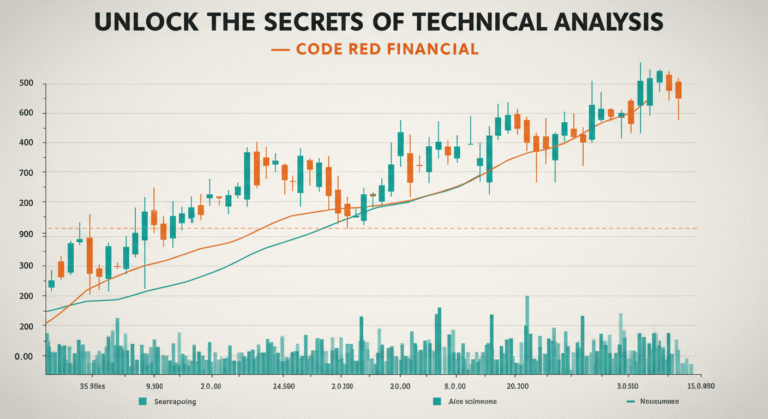
There’s a certain primal thrill, an almost heroic impulse, that surfaces in the heart of many investors when they spot a stock plummeting. It’s the financial equivalent of seeing a damsel in distress – you want to swoop in, be the hero, and rescue value from the clutches of panic. This daring maneuver is famously known as “catching a falling knife.” The dream is intoxicatingly simple: reach out, deftly grab the handle (the precise moment the stock bottoms out and starts to recover), and completely avoid the razor-sharp blade (the continued, devastating decline that slices through your capital). You envision yourself as the savvy contrarian, buying fear when others are paralyzed, destined for outsized returns.
It’s a narrative woven deeply into market lore – the promise of acquiring assets at fire-sale prices just before a glorious rebound. But let’s pull back the curtain and inject a healthy dose of reality: this high-stakes, high-wire act has inflicted more financial wounds than it has created legendary fortunes. It’s a strategy fundamentally layered with immense risk, often culminating in significant losses and profound regret. Yet… the allure persists because, under the right circumstances, with the right analysis and discipline, it can yield spectacular results.
So, how does one even begin to approach this dangerous yet potentially rewarding strategy? Is it pure luck, or can skill play a role? Let’s embark on a deeper exploration – dissecting the intricate risks, the potential rewards, the crucial difference between informed speculation and outright gambling, the stark contrast between a falling giant like Microsoft and a fundamentally flawed company, and the diverse mindsets traders employ when facing a sea of red on their screens.
The Siren Song: Why Plummeting Prices Are So Irresistibly Tempting
Human psychology plays a massive role here. Seeing a stock you recognize, perhaps one you even admired at higher prices, suddenly become dramatically cheaper triggers powerful cognitive biases:
- Anchoring Bias: We tend to anchor our perception of a stock’s value to its recent highs. When it drops 30%, 40%, or even 50%, our anchored brain screams “Bargain!” even if that new, lower price is still overvalued based on current realities.
- Fear of Missing Out (FOMO): As a stock falls, the thought “What if this is the bottom?” can be overwhelming. The fear of missing out on a potential V-shaped recovery can push investors to jump in prematurely.
- The Illusion of Control: We often overestimate our ability to predict market movements. Catching a falling knife feels like exerting control over chaos, timing the market perfectly – a feat even seasoned professionals struggle with consistently.
The promise is simple: buy low, sell high. It’s the fundamental mantra of investing. Catching a falling knife seems like the ultimate expression of this mantra – buying at the absolute low. But this overlooks the critical question: why is the knife falling in the first place?
Gravity’s Harsh Reality: Why Knives Often Keep Falling
Stocks don’t typically nosedive in a vacuum. There are usually powerful forces at play, and understanding these is crucial before even thinking about buying:
- Company-Specific Bad News: This is often the most direct cause. Poor earnings reports, loss of a major contract, product failures, accounting irregularities, management scandals, or disastrous litigation can fundamentally impair a company’s value and future prospects. The fall isn’t just market noise; it’s a reflection of genuine deterioration.
- Sector-Wide Problems: Sometimes, an entire industry faces headwinds. New regulations, disruptive technology (think Blockbuster vs. streaming), changing consumer preferences, or rising input costs can drag down all players in a sector, even the relatively strong ones.
- Macroeconomic Storms: Recessions, rising interest rates, geopolitical crises, or pandemics can trigger broad market sell-offs. In these scenarios, even healthy companies get caught in the downdraft as investors flee risk assets en masse. Fear becomes contagious.
- Panic Selling & Forced Liquidation: Once a stock starts falling sharply, it can trigger margin calls for leveraged investors or stop-loss orders, creating a cascade of forced selling that pushes the price down further and faster, often temporarily detaching it from its underlying fundamental value. Technical breakdowns on charts can exacerbate this.
Ignoring why the stock is falling is like trying to catch that knife blindfolded. The reason for the decline is paramount in assessing the probability of a recovery.

The Perilous Pitfalls: A Deeper Dive into the Risks
Attempting to catch a falling knife isn’t just risky; it’s fraught with specific dangers that can ambush even well-intentioned investors:
- The Dreaded Value Trap: This is the silent killer. A stock looks cheap based on historical metrics (like a low Price-to-Earnings ratio), tempting value-conscious investors. However, the “E” (Earnings) are collapsing, or the assets are worth less than believed. The stock is cheap, but it’s cheap for a reason and likely to get even cheaper or stagnate indefinitely. Think of companies disrupted by technology that never recovered their former glory.
- Dividend Traps: Sometimes, a falling stock price pushes the dividend yield to very attractive levels. Investors jump in for the income, only to see the company, buckling under financial pressure, cut or suspend the dividend entirely, leading to further price declines. The high yield was a warning sign, not an opportunity.
- Capital Decimation & The Point of No Return: If you buy a stock at $50, and it falls to $25, you’ve lost 50%. But for that stock to get back to your break-even point of $50, it needs to gain 100% from $25. The deeper the cut, the exponentially harder the recovery becomes for your initial investment. Continued declines can wipe out significant portions of your capital.
- The Crushing Weight of Opportunity Cost: Every dollar you tie up in a falling knife that continues to bleed is a dollar you cannot invest in other, potentially thriving opportunities. Holding onto hope in a losing position prevents you from deploying capital more productively elsewhere.
- The Emotional Gauntlet & Psychological Biases: This cannot be overstated. Watching your investment shrink daily induces stress, anxiety, and fear. This can lead to:
- Panic Selling: Selling near the bottom out of sheer terror, locking in maximum losses.
- Stubborn Holding (Loss Aversion): Refusing to sell a losing position because admitting the mistake is too painful, hoping it will somehow “come back.”
- Reckless Averaging Down: Throwing good money after bad by buying more shares as the price falls without confirming if the initial investment thesis is still valid, just to lower the average purchase price.
When Might It Make Sense? The Crucial Role of Fundamentals (Microsoft vs. Hypothetical WeakCo)
This is where diligent research separates potential strategic plays from pure gambles. Not all falling stocks are destined for the graveyard.
Consider Microsoft (MSFT) again. As of early 2025, it remains a tech behemoth. Let’s flesh out why its potential dips might be viewed differently:
- Fortress Balance Sheet: Billions in cash reserves, manageable debt levels. This financial cushion allows it to weather economic storms, invest heavily in R&D (like AI), and make strategic acquisitions.
- Diversified Revenue Streams: Cloud (Azure), Software (Windows, Office 365), Gaming (Xbox), Professional Networking (LinkedIn). This diversification reduces reliance on any single product line.
- Economic Moat: Strong competitive advantages – network effects (Office/Windows ecosystem), high switching costs (Azure cloud infrastructure), intangible assets (brand reputation, patents). It’s difficult for competitors to dislodge Microsoft from its core markets.
- Proven Management & Innovation: A track record of adapting and leading in technological shifts (cloud, now AI).
If Microsoft’s stock were to fall 20% due to a general market downturn or temporary sector rotation, a fundamental analyst might argue the long-term value proposition remains intact or is even enhanced at the lower price. The reason for the drop doesn’t appear to fundamentally break the company’s core strengths. Buying here is still risky (it could fall further!), but it’s based on an assessment of underlying, durable value.
Now, contrast this with Hypothetical WeakCo Inc. Imagine a small retailer with declining same-store sales, rising debt, facing intense online competition, and possessing a weak brand. If its stock plunges 50% after a terrible earnings report, is it a bargain? Probably not. The falling price reflects a deteriorating business model. Buying WeakCo is catching a knife falling because it’s fundamentally broken, a far riskier proposition than buying a temporarily discounted, fundamentally sound giant like Microsoft.
The Technical Trader’s Toolkit: Seeking Signs of Stabilization
While fundamental analysis assesses why a stock should recover, technical analysis focuses on when it might actually start to do so, by studying price action and volume. Technical traders aren’t necessarily concerned with the company’s intrinsic value; they’re looking for clues in market behavior:
- Support Levels: Identifying historical price levels where the stock has previously stopped falling and bounced. A falling stock approaching a major, historically tested support level might attract technical buyers.
- Volume Analysis: A sharp decline on decreasing volume might suggest selling pressure is easing. Conversely, a final, massive spike in volume (capitulation volume) can sometimes signal that the weakest hands have finally thrown in the towel, potentially marking a bottom.
- Candlestick Patterns: Specific patterns formed by daily price bars can indicate potential reversals. A “hammer” (long lower wick, small body near the top) after a decline, or a “bullish engulfing” pattern (a large green candle engulfing the prior red candle), might suggest buyers are stepping in.
- Momentum Indicators (like RSI): The Relative Strength Index (RSI) measures the speed and change of price movements. An “oversold” reading (typically below 30) on the RSI, especially if combined with “bullish divergence” (price makes a new low, but RSI makes a higher low), can signal that the downward momentum is waning.
Important Caveat: Technical signals are not crystal balls. Support levels can break, patterns can fail, and indicators can give false signals. They are tools for assessing probabilities, not certainties, and are often best used in conjunction with fundamental analysis.
Trader Mindsets: Who Dares to Catch the Knife?
Let’s revisit the key trader archetypes and how they might specifically engage with a falling knife scenario:
- The Fundamental Detective: Might buy if their deep-dive confirms the company remains strong and the market is overreacting. They often have price targets based on intrinsic value and may slowly accumulate shares as the price falls towards their target zone. Patience is their virtue.
- The Chart Whisperer (Technical Trader): Waits for specific technical signals – a bounce off support, a reversal pattern confirmed by volume, divergence on an indicator – before entering. Their holding period might be shorter, aiming to capture the initial rebound. Strict stop-losses are usually employed.
- The Contrarian: Actively seeks out stocks that are hated and oversold. They thrive on fear. They might buy before clear confirmation, betting that sentiment is overly pessimistic and will eventually revert. Requires strong conviction and tolerance for being “wrong” initially.
- The Value Hunter: Similar to the fundamental detective but perhaps even more price-sensitive. They calculate what they believe the business is worth and are only interested if the falling knife brings the price significantly below that calculated value, offering a “margin of safety.”
- The Gambler (Noise Trader): Buys simply because the price dropped a lot, maybe based on a hot tip or social media hype, without doing real research. This is the approach most likely to end in disaster.
Strategy vs. Gambling: The Crucial Role of Risk Management
This is arguably the most critical differentiator. Catching falling knives without a robust risk management plan is gambling. Strategic approaches incorporate:
- Position Sizing: Never bet the farm on a single falling knife. Determine beforehand what percentage of your portfolio you are willing to risk on this high-probability-of-failure trade. Keeping positions small mitigates the impact of inevitable losses.
- Stop-Loss Orders: Placing an order to automatically sell your position if the stock falls to a predetermined price level. This limits your downside if the order executes effectively (beware of gaps down in price). It enforces discipline and prevents catastrophic losses on a single trade.
- Understanding Averaging Down: Buying more shares as the price falls can lower your average cost basis. However, doing this blindly on a fundamentally weak stock is like throwing good money after bad. Strategic averaging down should only be considered if: a) the initial position size was small, b) your conviction in the fundamental recovery story increases or is re-affirmed, and c) you have predefined limits. It’s a dangerous tool if misused.
- Thorough Due Diligence: Never buy just because it’s falling. Understand why. Read company reports, analyst opinions (with skepticism), news, and assess the balance sheet health before putting capital at risk.
The Psychology of the Catch: Mastering Your Inner Market
Successfully navigating falling knives requires immense mental fortitude:
- Conquering Fear: Seeing red on your screen triggers primal fear responses. You need the discipline to stick to your pre-defined plan (entry points, stop-losses) rather than reacting emotionally.
- Avoiding Premature FOMO: Resist the urge to jump in too early just because the price looks “cheap” relative to yesterday. Wait for your specific entry criteria (fundamental or technical) to be met.
- Battling Confirmation Bias: Actively seek out information that challenges your belief that the stock will recover. Don’t just look for news that confirms your hopes.
- Discipline is Paramount: The ability to execute your plan, cut losses quickly when wrong, and avoid impulsive decisions under pressure is what separates disciplined speculators from gamblers.
Market Context Matters: Bull vs. Bear Environments
A falling knife behaves differently depending on the overall market weather:
- Bull Market: In a strong uptrending market, dips are often bought more quickly. A fundamentally sound company experiencing a temporary setback might find buyers more readily. The overall positive sentiment provides a tailwind.
- Bear Market: In a declining market, falling knives are far more dangerous. Stocks can fall much further than expected as fear dominates. Support levels break more easily, and fundamentally weak companies are often punished severely. Catching knives in a bear market requires extreme caution and selectivity.
Final Thoughts: Handle with Extreme Caution and Strategic Intent
The image of catching a falling knife perfectly – buying at the nadir, riding the triumphant recovery – is undeniably captivating. It speaks to our desire for cleverness, for beating the market, for turning fear into fortune. However, this allure masks a treacherous reality. It is one of the highest-risk maneuvers in investing.
Success, when it occurs, is rarely pure luck. It’s typically the result of meticulous research (understanding the why and assessing the what – the company’s fundamental strength), careful timing (using technical analysis as a guide, not a guarantee), stringent risk management (position sizing, stop-losses), and profound emotional discipline. Knowing the difference between a temporarily troubled giant like Microsoft and a fundamentally flawed entity is paramount.
Catching falling knives should never be the cornerstone of a sound investment strategy. It is a tactic for the experienced, the well-researched, and those with a high tolerance for risk and potential loss. If you choose to engage, do so with your eyes wide open, your research thorough, your position sizes small, and your exit strategy clearly defined before you ever place the trade. Treat it not as a path to easy riches, but as a calculated, high-stakes speculation within a broader, diversified portfolio. Approach with caution, respect the risks, and prioritize the preservation of your capital above the heroic allure of the catch.




